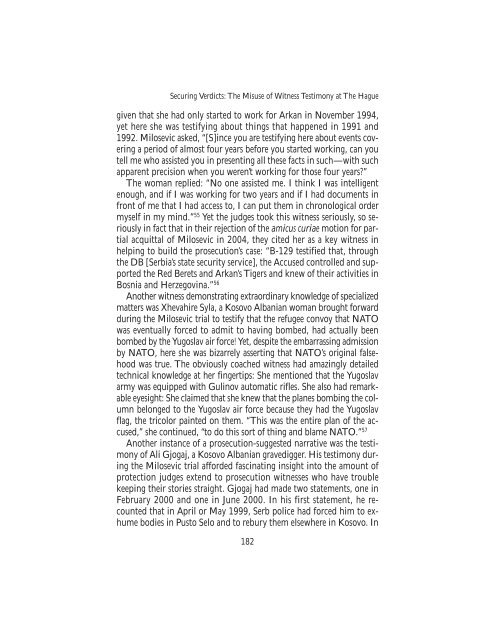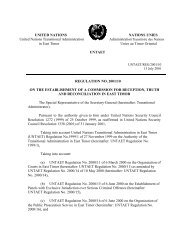The Srebrenica Massacre - Nova Srpska Politicka Misao
The Srebrenica Massacre - Nova Srpska Politicka Misao
The Srebrenica Massacre - Nova Srpska Politicka Misao
You also want an ePaper? Increase the reach of your titles
YUMPU automatically turns print PDFs into web optimized ePapers that Google loves.
Securing Verdicts: <strong>The</strong> Misuse of Witness Testimony at <strong>The</strong> Hague<br />
given that she had only started to work for Arkan in November 1994,<br />
yet here she was testifying about things that happened in 1991 and<br />
1992. Milosevic asked, “[S]ince you are testifying here about events covering<br />
a period of almost four years before you started working, can you<br />
tell me who assisted you in presenting all these facts in such—with such<br />
apparent precision when you weren’t working for those four years?”<br />
<strong>The</strong> woman replied: “No one assisted me. I think I was intelligent<br />
enough, and if I was working for two years and if I had documents in<br />
front of me that I had access to, I can put them in chronological order<br />
myself in my mind.” 55 Yet the judges took this witness seriously, so seriously<br />
in fact that in their rejection of the amicus curiae motion for partial<br />
acquittal of Milosevic in 2004, they cited her as a key witness in<br />
helping to build the prosecution’s case: “B-129 testified that, through<br />
the DB [Serbia’s state security service], the Accused controlled and supported<br />
the Red Berets and Arkan’s Tigers and knew of their activities in<br />
Bosnia and Herzegovina.” 56<br />
Another witness demonstrating extraordinary knowledge of specialized<br />
matters was Xhevahire Syla, a Kosovo Albanian woman brought forward<br />
during the Milosevic trial to testify that the refugee convoy that NATO<br />
was eventually forced to admit to having bombed, had actually been<br />
bombed by the Yugoslav air force! Yet, despite the embarrassing admission<br />
by NATO, here she was bizarrely asserting that NATO’s original falsehood<br />
was true. <strong>The</strong> obviously coached witness had amazingly detailed<br />
technical knowledge at her fingertips: She mentioned that the Yugoslav<br />
army was equipped with Gulinov automatic rifles. She also had remarkable<br />
eyesight: She claimed that she knew that the planes bombing the column<br />
belonged to the Yugoslav air force because they had the Yugoslav<br />
flag, the tricolor painted on them. “This was the entire plan of the accused,”<br />
she continued, “to do this sort of thing and blame NATO.” 57<br />
Another instance of a prosecution-suggested narrative was the testimony<br />
of Ali Gjogaj, a Kosovo Albanian gravedigger. His testimony during<br />
the Milosevic trial afforded fascinating insight into the amount of<br />
protection judges extend to prosecution witnesses who have trouble<br />
keeping their stories straight. Gjogaj had made two statements, one in<br />
February 2000 and one in June 2000. In his first statement, he recounted<br />
that in April or May 1999, Serb police had forced him to exhume<br />
bodies in Pusto Selo and to rebury them elsewhere in Kosovo. In<br />
182



